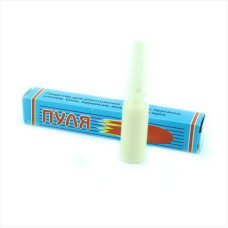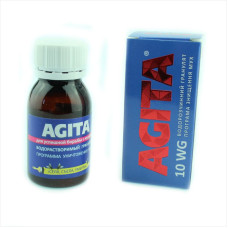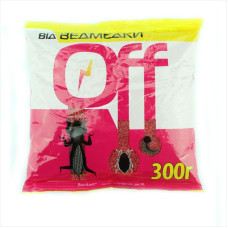In stock
Product Code: 13553
Actellic (Original) - is a non-systemic organophosphorus insectoacaricide with contact and stomach action, intended for protecting agricultural crops such as cherry and strawberry, both in open fields and protected environments, from a range of leaf-..
$3.99
In stock
Product Code: 15584
Insecticide «Yamato» - broad-spectrum insecticide for protecting crops of sugar beet, raspberry, cherry, peach, sweet pepper, eggplant, cucumbers and tomatoes (open ground), currant, gooseberry, ornamental crops, medicinal plants from weevils, aphids..
$1.49
In stock
Product Code: 15575
Insect repellent «Liquid Bullet» (Regent 200) - white product in an ampoule for killing cockroaches, Prussians, bedbugs, fleas, ants, and the Colorado potato beetle.
Active ingredient: tebufenpyrad 200 g/kg.
Advantages:
The product is qui..
$0.99
In stock
Product Code: 15593
Insecticide (gel syringe) «Ultra Magic» - a universal remedy for cockroaches and ants. It is a bait and contains an effective active ingredient. Ants or cockroaches drag away the gel particles and as a result the entire colony dies.
To treat ants,..
$1.99
In stock
Product Code: 15583
Insecticide «Targan Off» - disinfection agent for protection and elimination of domestic crawling and flying insects (cockroaches, Prussians, fleas, moths and ants).
Use of the agent is permitted in residential premises, food industry enterprises,..
$1.49
In stock
Product Code: 15586
Insecticide «Attack Chafer» - an insectoacaricide in the form of a suspension concentrate containing the active substance spirodiclofen 240 g/l, as well as an adhesive and special auxiliary substances.
Due to its composition, the pest control prod..
$1.49
In stock
Product Code: 15539
Insecticide «Goodwin + Avangard Grow Amino» - a two-component set of highly effective insecticide of contact-systemic action and anti-stress agent for foliar feeding of crops.
Active substance: goodwin (clothianidin, 200 g/l + alpha-cypermethrin, ..
$1.49
In stock
Product Code: 15568
Insecticide «Inspirator» - systemic insecticidal tablets that protect against sucking and leaf-eating pests and promote better engraftment of seedlings of fruit, forest and ornamental crops, and also supply them with essential nutrients.
Compositi..
$0.99
In stock
Product Code: 16142
Insecticide «Milady» - іt is a contact-systemic insecticide in tablets, which also serves as a mineral supplement for indoor ornamental plants in closed soils, providing them with protection from leaf-eating and sucking insect pests. The main active ..
$0.99
In stock
Product Code: 15528
Insecticide «Agita 10WG» - an insecticide in the form of water-soluble crystals is used to quickly destroy flies, wasps, fleas, cockroaches, bedbugs, ants, mosquitoes in domestic conditions. The highly effective active ingredient of the latest genera..
$2.49
In stock
Product Code: 15546
Bioinsecticide «Aktoverm» - a biological product with insecticidal and acaricidal action to protect vegetables and gardens from pests.
The product contains a complex of natural avermectins - Aversectin C (0.2%), which is formed during the life of ..
$1.99
In stock
Product Code: 15578
Cable powder insecticide «Thiuram» - a highly effective insecticide used to kill cockroaches, red ants, moths and other harmful insects.
Active ingredient: tetramethylthiuram disulfide.
Advantages:
It has a broad spectrum of action and is..
$0.99
In stock
Product Code: 15599
Bio-insecticide «Aktofit» - an ecological product, without the use of chemical components, for combating a wide range of insects (including mites) on vegetable, fruit and berry plants, as well as on ornamental shrubs.
Active substance: avermectin ..
$1.99
In stock
Product Code: 15520
Cockroach, bedbug and flea control product «Frontline M» - the contact-intestinal insecticide is designed to treat industrial and domestic premises, summer outbuildings, warehouses, food service areas, cafes, restaurants, hotels, medical institutions..
$1.49
In stock
Product Code: 15598
Insecticide «Mole crickets Off» (Medvedka Off) - a drug against mole crickets (cabbage mole) developed on the basis of the Rembek drug in the form of an extrusion granule.
The composition of the product includes 2 active substances: imidacloprid 0..
$1.99
In stock
Product Code: 15582
Insecticide «Mrowkofon» (Mrovkofon) - a very well-known Polish product for fighting garden and domestic ants both in vegetable plots and indoors.
The product can be used in two ways
Use by sprinkling:
Tear off the edge of the package. Sprink..
$1.49
In stock
Product Code: 15526
The drug «Bio AntiBug Hydro» - a systemic insecticide of contact-intestinal action for the protection of potatoes from the Colorado potato beetle. Antizhuk is also used to protect fruit trees, vegetable and flower crops from pests such as codling mot..
$1.99
In stock
Product Code: 15525
Insecticide (effervescent tablet) «Super Attack Active» - insecticide Super Attack Active in the form of effervescent fast-dissolving tablets is used to protect a complex of agricultural crops from the Colorado potato beetle and other hard-to-remove ..
$1.49
In stock
Product Code: 15597
Bio-insecticide «Zamorin» - the preparation is based on bacteria and their vital processes - toxins Bacillus thuringiensis (lat.) - a type of gram-positive, spore-forming soil bacteria.
Cells and specific crystalline protein endotoxin exhibit inse..
$1.99
In stock
Product Code: 15595
Insecticide (syringe-gel) «Anti-fly» - an effective and original preparation for combating flying (flies) and running (fleas and cockroaches) insects in public places and places where domestic animals are kept, nurseries or in barns and industrial po..
$1.99
In stock
Product Code: 15572
Insecticide «Mostart» (analogues: Mospilan) - systemic insecticide with contact-intestinal action. Destroys insect pests in the garden and on potatoes within 24 hours. The preparation is completely safe for bees, can be used during the flowerin..
$0.99
In stock
Product Code: 15590
Insecto-acaricide «Omite» - it is used to destroy most types of herbivorous mites on vegetable, fruit and berry, ornamental and flower crops.
Active ingredient: propargite, at a concentration of 570 g / kg.
Advantages:
A contact acaricide..
$0.99
In stock
Product Code: 15573
Insecticide «Akt» - insecticide of intestinal-contact action, intended for protection of grain crops, potatoes, beets, currants, peas, fruit trees, vegetable and flower crops.
Inhibits pests: leafhoppers, aphids, thrips, whiteflies, codling moths,..
$0.99
In stock
Product Code: 15577
Insecticide «Attack Aphid» - a insecticide in the form of a suspension concentrate, which includes the active substance spirodiclofen 240 g / l, as well as an adhesive and special auxiliary substances.
Due to its composition, it has the following ..
$0.99
Various protective measures are used to protect against pests. Some of them simply scare away unwanted guests, and the second – kill. One of the – repellents that can be applied to the skin, plugged into an outlet, splashed, or set on fire. The composition is completely different, on which the result depends.
The main types of insecticides
A species that kills insects is called an insecticide. Such varieties are capable of harming crops and cultivated plants. The products are popular among farmers, owners of small plots of land or private houses. Products are classified according to three criteria: sensitive to organisms, according to the principle of operation and the route of penetration into the body of an insect, and according to chemical composition.
In the first group, the following varieties are distinguished: aficides – are used against aphids, insectoacaricides – against insects and mites, larvicides – kill larvae, ovicides – act on pests in the egg stage, attractants and pheromones – perform the function of a trap, repellent – scare away, sterilizers – oppress the generative function, the afidants – reduce appetite.
Depending on the principle of operation, there are the following types: system action – kill pests in the middle of the plant, toxic effect on parasite-eaters. Second – contact, which function when it enters the body of the parasite. Intestinal act by poisoning when it enters the stomach. Products that produce smoke that enters the respiratory tract – fumigants.
There are also products that affect the nervous system, receptors for the transmission of nerve impulses, oxidative phosphorylation and synthesis of chitin. Depending on the composition, the following categories are distinguished: organochlorine, organophosphorus and pyrethroids. The former kill insects within a week and are considered the oldest product. There are such disadvantages: increased toxicity and unsafety for human health and the environment.
Phosphorus organics are not so toxic and, subject to all standards, act quite effectively and quickly. They include "Fufanon", "Dichlorvos", "Karbofos". The third group affects the nervous system of the parasite and does not harm human health. Representatives: "Fastak", "Decis". There are such general operating features: photostability, with partial modification, the activity of each of the molecules is preserved, the activity is maintained even with a decrease in toxicity. The price depends on the choice of product.
In the first group, the following varieties are distinguished: aficides – are used against aphids, insectoacaricides – against insects and mites, larvicides – kill larvae, ovicides – act on pests in the egg stage, attractants and pheromones – perform the function of a trap, repellent – scare away, sterilizers – oppress the generative function, the afidants – reduce appetite.
Depending on the principle of operation, there are the following types: system action – kill pests in the middle of the plant, toxic effect on parasite-eaters. Second – contact, which function when it enters the body of the parasite. Intestinal act by poisoning when it enters the stomach. Products that produce smoke that enters the respiratory tract – fumigants.
There are also products that affect the nervous system, receptors for the transmission of nerve impulses, oxidative phosphorylation and synthesis of chitin. Depending on the composition, the following categories are distinguished: organochlorine, organophosphorus and pyrethroids. The former kill insects within a week and are considered the oldest product. There are such disadvantages: increased toxicity and unsafety for human health and the environment.
Phosphorus organics are not so toxic and, subject to all standards, act quite effectively and quickly. They include "Fufanon", "Dichlorvos", "Karbofos". The third group affects the nervous system of the parasite and does not harm human health. Representatives: "Fastak", "Decis". There are such general operating features: photostability, with partial modification, the activity of each of the molecules is preserved, the activity is maintained even with a decrease in toxicity. The price depends on the choice of product.
Key features
Any type can be bad for human health or bad for the environment. For industrial processing, FOS and pyrethroids are used. For use and processing in summer cottages, private sectors and for the garden, the first mentioned varieties are put into operation, which are non-toxic for warm-blooded animals.
The second insecticides are more toxic, but quickly dissolve in the environment. Before use, you should carefully read the instructions and follow all safety standards so as not to harm yourself and others. In the worst case, the product may cause intoxication. In this case, you should seek help from doctors.
If the drug gets on exposed skin, rinse quickly with running water. The drug may consist of a single component or be with additives: fragrances or masking the odors of the main component. There are products that are used only by specialists and ordinary people for domestic use. Many buyers use anti-cockroach drugs, which is a problem for both large private houses and apartments.
According to the degree of danger to the human body, four groups are distinguished: especially toxic, with high toxicity, medium hazard and low toxicity. With proper operation, the third and fourth types are used in sanatoriums and medical institutions. Many drugs have such disadvantages: you need to properly prepare the product before use, an unpleasant and persistent odor, a short duration of action – usually no more than two weeks, which makes it worth re-treatment.
Microcapsular varieties do not have such disadvantages. With a good choice, the plant will quickly get rid of pests. The main thing is to follow the basic rules: follow the instructions, processing should take place with fresh products, choose trusted manufacturers, do not use expired products.
The second insecticides are more toxic, but quickly dissolve in the environment. Before use, you should carefully read the instructions and follow all safety standards so as not to harm yourself and others. In the worst case, the product may cause intoxication. In this case, you should seek help from doctors.
If the drug gets on exposed skin, rinse quickly with running water. The drug may consist of a single component or be with additives: fragrances or masking the odors of the main component. There are products that are used only by specialists and ordinary people for domestic use. Many buyers use anti-cockroach drugs, which is a problem for both large private houses and apartments.
According to the degree of danger to the human body, four groups are distinguished: especially toxic, with high toxicity, medium hazard and low toxicity. With proper operation, the third and fourth types are used in sanatoriums and medical institutions. Many drugs have such disadvantages: you need to properly prepare the product before use, an unpleasant and persistent odor, a short duration of action – usually no more than two weeks, which makes it worth re-treatment.
Microcapsular varieties do not have such disadvantages. With a good choice, the plant will quickly get rid of pests. The main thing is to follow the basic rules: follow the instructions, processing should take place with fresh products, choose trusted manufacturers, do not use expired products.
























